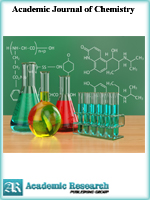Academic Journal of Chemistry
Online ISSN: 2519-7045
Print ISSN: 2521-0211
Print ISSN: 2521-0211
Quarterly Published (4 Issues Per Year)

Archives
Volume 5 Number 5 May 2020
Determination of the Levels of Lead and Cobalt from Soils of an Irrigated Farmland in Lafia Nasarawa State-Nigeria Using Two Different Methods of Digestion
Authors: Augustine U. A. ; Akpomie T. M. ; Balarabe S. ; Ishaq B.
Pages: 48-54
DOI: doi.org/10.32861/ajc.55.48.54
Abstract
Washing of vehicles (lorries, cars, buses and motor-bikes), clothes and kitchen utensils, bathing and the release of smoke from exhausts of motor-vehicles and other anthropogenic sources continuously increase the levels of heavy metals in water bodies, especially the Amba river of Lafia used for the irrigation of farmlands thereby resulting to contamination and elevation of heavy metals uptake by crops. This study was carried out to provide information on heavy metals concentration in soils of an irrigated vegetable farmland in Lafia. Soil samples were collected at surface levels of 0-30 cm depth. Samples were analyzed for pH, organic matter, electrical conductivity and soil particle sizes. The soil samples were digested using Aqua regia and Nitric acid methods of digestion. The concentrations of lead (Pb) and cobalt (Co) were determined by Atomic Absorption Spectrophotometric (AAS) technique. The values of soil pH ranged between 5.60 and 6.35, organic carbon between, 1.40-1.49 %, organic matter content between, 2.40 and 2.57 %, electrical conductivity between 100 and 240 μS cm –1 and clay, sand and silt content between 10.4-11.4 %, 82-85 % and 4.6-6.6 % respectively. Total concentration of extractable Pb and Co (Aqua regia method) ranged between 0.083–0.105 and 1.473 – 1.573 mg kg-1 respectively. The concentrations of heavy metals for Nitric acid method were as follows: Pb: 1.363-1.512 and Co: 0.060-0.086. Concentrations of heavy metals in both methods were all below DPR-EGASPIN (2002) and US EPA. (2014) recommended limits. The results showed that aqua regia method was more efficient than the Nitric acid Method of digestion.
Influence of Organic Dye Ligands on the Photocatalytic Reduction of Copper Ions in Aqueous Solution Using UV-Nano TIO2 System
Authors: Ekwere I. O.
Pages: 41-47
DOI: doi.org/10.32861/ajc.55.41.47
Abstract
This study investigates the influence of some organic dyes on the photocatalytic reduction of Cu (II) ions in aqueous solution. The dyes of interest were Eosin red, Eriochrome black T, Bromothymol blue and Malachite green. Slurry photoreactor design, with nano-sized titanium dioxide photocatalysts, and illuminated by a 15 W UV light, was utilized. Results showed that the percentage reduction of Cu (II) ions altered from 44.7% (without dye) to 25.7% (with ER), 60.7% (with EBT), 15.2% (with BTB) and 17.8% (with MG) after 60 minutes reaction time at pH 5. This implies that EBT enhanced Cu (II) ions reduction while the other three dyes inhibited the photoreduction process. The kinetic study indicated that the photo-reduction of Cu (II) ions followed the pseudo-first-order kinetics, with the exception of Cu-MG reduction which gave the best correlation values in zeroth-order plot. Statistical analysis was carried out with the ANOVA, Dunnetts post-hoc and Tukeys post-hoc multiple comparison tests. Tukeys post-hoc multiple comparison test was effected to determine the pair of Cu (II) ions with significant difference in mean values while Dunnetts post-hoc was effected to compare the measured values with the initial values. Photoreduction of Cu (II) ions were considered significant at P< 0.05 and 95% confidence interval.



